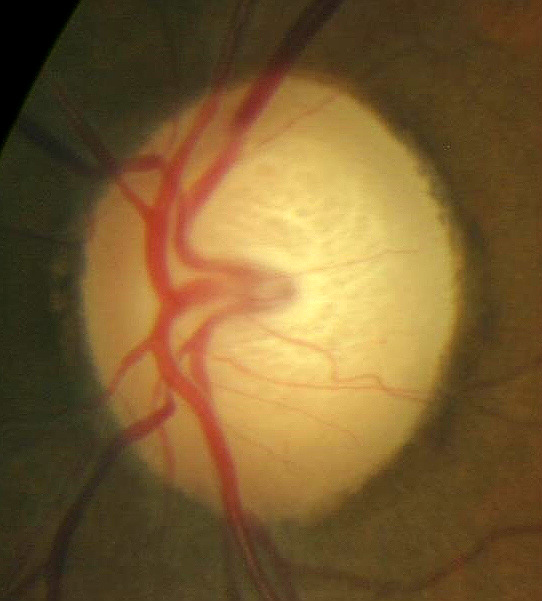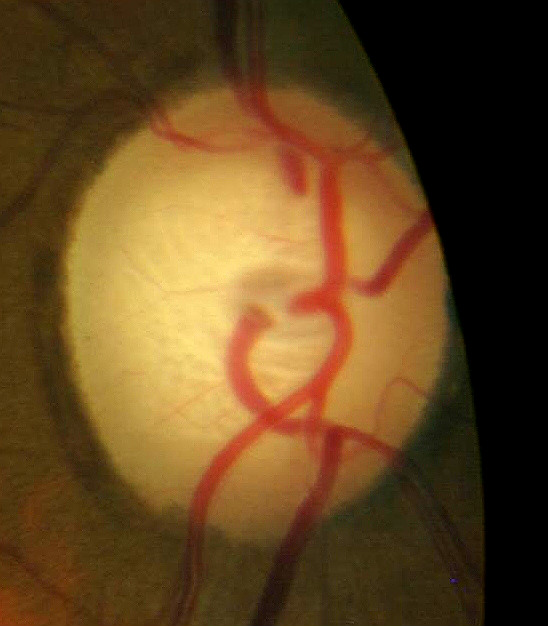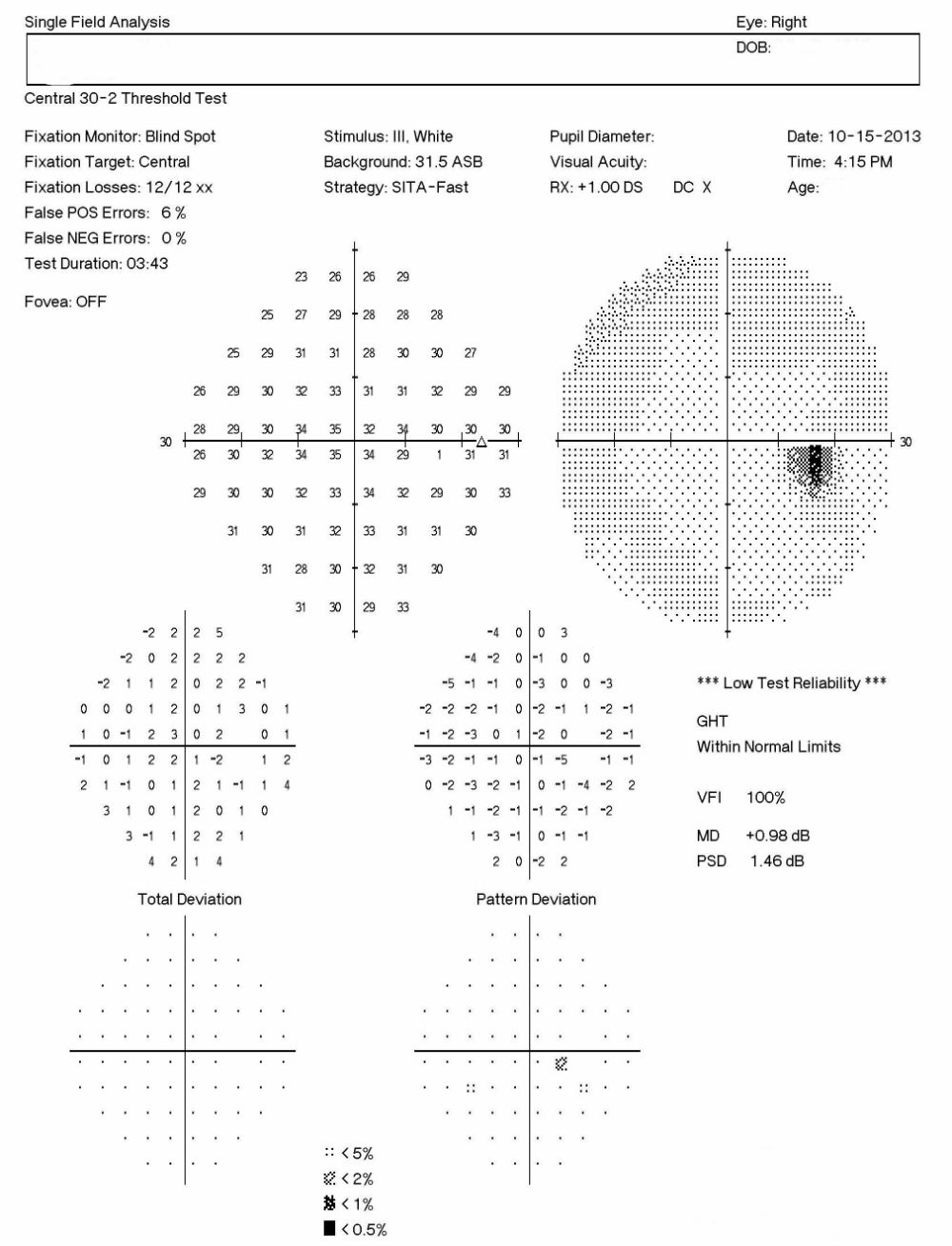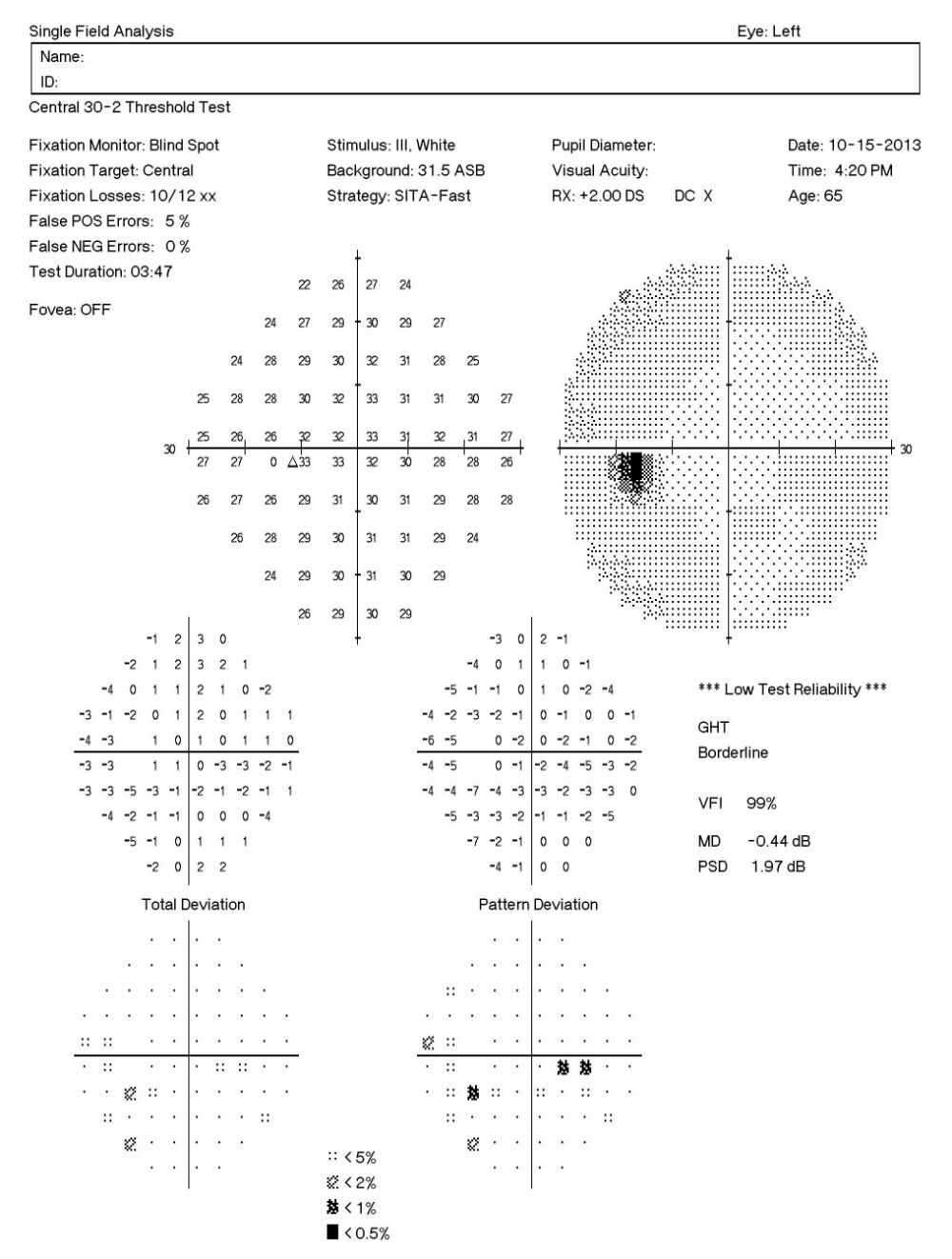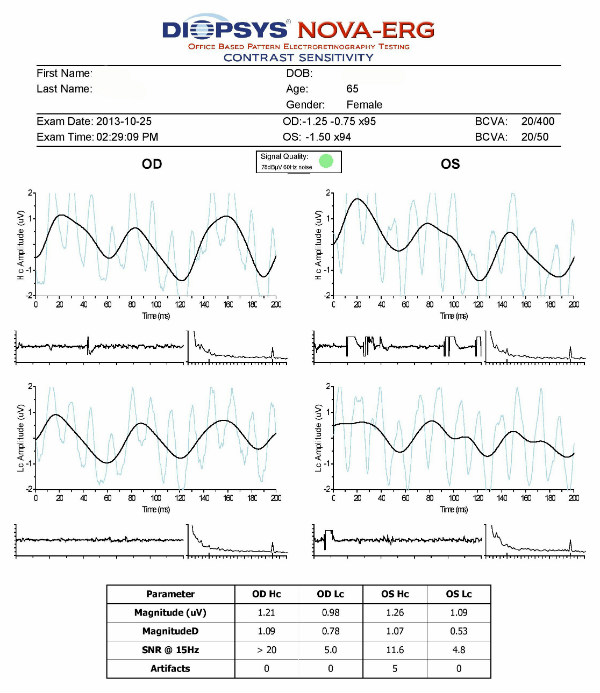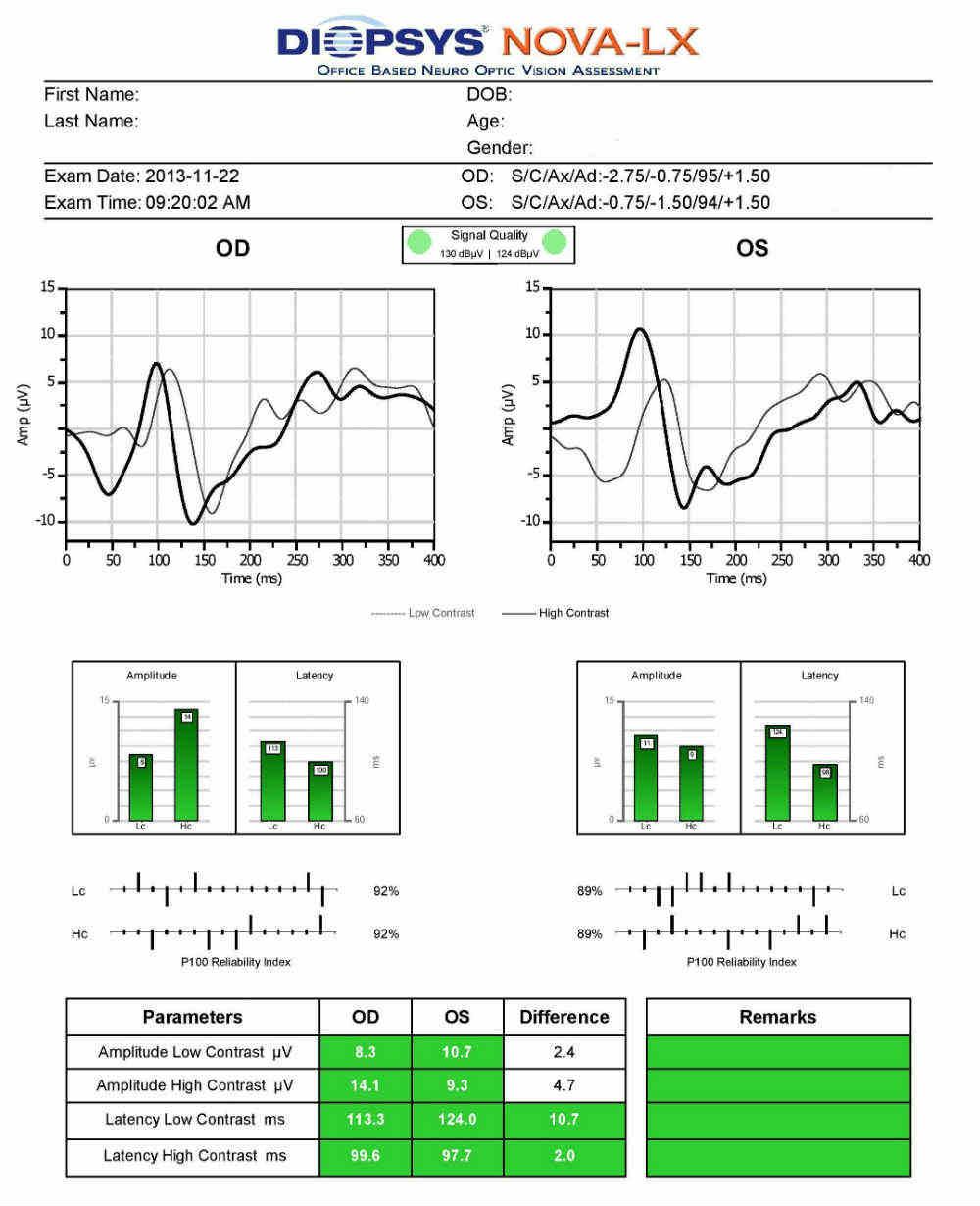Case Report ID: 28
Title
Open-Angle Glaucoma Suspect; Low Risk
Category
Glaucoma (8)
Description
This case presents the diagnosis and treatment of a patient suspicious for developing glaucoma.
Glaucoma is an optic neuropathy showing distinctive changes in optic nerve morphology without associated pallor. The term “glaucoma” refers to a group of chronic, progressive optic neuropathies that have in common characteristic morphologic changes at the optic nerve and retinal nerve fiber layer.
The glaucomas are associated with the following clinical features:
- Aqueous outflow restrictions
- Unphysiologic intraocular pressure
- Abnormal ocular perfusion
- Abnormal rate of apoptosis
- Progressive retinal ganglion cell loss
- Characteristic changes in optic nerve anatomy
Case Report
- A 65-year-old black woman presented with a complaint of “decreased vision“
- Case history revealed that the only visual complaint was difficulty when reading
- The patient wore prescription eyeglasses and wanted to see if a new prescription would improve her vision
Conclusion
Glaucoma is a diagnosis of exclusion. According to the 2012 ICD-9 diagnosis codes, persons are considered open-angle glaucoma suspects based on the number of risk factors they possess. Low-risk is one or two risk factors. High-risk is three or more risk factors. Commonly considered risk factors include:
- Positive family history for glaucoma
- Black or Hispanic race
- Elevated intraocular pressure
- Abnormal optic disc appearance (especially vertical cup-to-disc changes)
- Thin central corneal thickness below 500 microns combined with elevated intraocular pressures
Additional risk factors not included in the ICD-9 listing include the following:
- Low blood pressure
- Sleeping / breathing disorders
- Diabetes
- Angle abnormalities / outflow restrictions
- Prior trauma to globe
History of Present Illness
- Associated Signs and Symptoms: none
- Location: n/a
- Duration: n/a
- Quality: n/a
- Context: decreased vision is more noticeable when driving at night
- Severity: mild decrease in vision
- Timing: vision seems to be getting worse over time
- Modifiers: none
Review of Systems
- The patient reported that he was in good health and taking no medications
Past, Family and Social History
- Non-contributory
Uncorrected Distance Visual Acuity
- 20/25 in the right eye
- 20/25 in the left eye
Best Corrected Distance Visual Acuity
- 20/25 in the right eye
- 20/25 in the left eye
Normal Examination Findings
- Mental status
- General medical observation
- Gross visual fields
- Pupils
- Basic sensorimotor examination
- External examination
- Adnexal examination
- External ocular examination with biomicroscopy
Intraocular Pressure Measurements (3:00 p.m.)
- 18mm Hg in the right eye
- 21mm Hg in the left eye
Population studies indicate that the average IOP is 15.5mm Hg +/- 2.6mm Hg.
Some studies suggest that there is a relationship between between the amount of intraocular pressure asymmetry and the likelihood of having glaucoma.
- A difference in IOP of 0mm Hg correlates with a 0.5% chance of having glaucoma
- A difference in IOP of 3mm Hg correlates with a 10% chance of having glaucoma
- A difference in IOP of 6mm Hg correlates with a 50% chance of having glaucoma
- A difference in IOP of more than 6mm Hg correlates almost 100% of the time with patients having glaucoma
Ophthalmoscopy
- Cup-to-disc ratio = .85/.85 in the right eye
- Cup-to-disc ratio = .80/.75 in the left eye
Clinical Diagnosis
The clinical diagnosis is a determination based on the knowledge obtained from the patient’s medical history and from the results of the eye examination alone, without the benefit of diagnostic tests or procedures.
The patient’s clinical diagnosis is open-angle glaucoma suspect, low-risk, based on the following risk factors:
- Abnormal optic disc appearance
- Black race
Treatment Plan
To gather the clinical information required to treat a patient diagnosed as an open-angle glaucoma suspect, low-risk, a diagnostic and treatment program is initiated.
- Determination of different types of diagnoses
- Selection of one or more treatment options
Glaucoma suspect is an interesting and unique diagnostic classification. Medicare specifically discourages the use of “non-specific” diagnoses or identifying a condition as probable, possible or likely. That being said, glaucoma suspect is considered a specific coding designation. It is still important to classify the severity of the presentation much like the disease of glaucoma. Patients identified as glaucoma suspects are categorized into low-risk or high-risk groups. Assigning a risk factor helps direct follow-up frequency and testing considerations.
After a clinical diagnosis has been determined, the diagnostic process continues with a process that involves the identification and exclusion of differential diagnoses. The differential diagnosis process allows the eye doctor to distinguish between two or more diseases with similar signs and symptoms by systematically comparing their signs and symptoms.
Differential Diagnoses
Much like glaucoma, the first differential diagnosis that needs to be determined in this patient is showing any glaucomatous optic neuropathy versus some other retinal or neurological disease. The list of possible differential diseases would include:
-
Retinal detachment
-
Pituitary tumors and other neurological conditions
-
Ischemic optic neuropathy
-
Vascular disease
-
Drusen of the optic disc
-
Congenital disc anomalies
Diagnostic Testing
When additional clinical information is needed to complete the differential diagnostic process, diagnostic tests and procedures are ordered.
The performance of these tests and procedures leads to the completion of the differential diagnostic process while simultaneously initiating the treatment program. Based on the clinical diagnosis of glaucoma suspect, the following diagnostic tests and procedures might be considered at the conclusion of the eye examination.
- Retinal nerve fiber layer scan
- Visual field examination
- Gonioscopy
- Fundus photography
- Visual evoked potential
- Electroretinography
- Serial tonometry
The decision to order and perform additional testing is totally based on the concept of medical necessity which can only be determined by the examining optometrist or ophthalmologist.
INITIAL EXAMINATION – DAY 1
Retinal Laser Scan – Nerve Fiber Layer
- Measuring the average retinal nerve fiber layer thickness provides an overall assessment of retinal health
- The procedure can be accomplished by using the Cirrus OCT manufactured by Carl Zeiss Meditec
Visual Field Examination
Automated threshold perimeters measure the visual field by plotting the threshold luminescence value of the patient in various locations in the visual field. The luminescence of the light stimulus is represented by non-specific units of measurement called decibels (dB).
Glaucoma produces several changes in the visual field, and one of these changes occurs as a widespread, non-descript loss of retinal sensitivity. In Tranquair’s “Hill of Vision” concept, loss of retinal sensitivity represents a reduction in the height of the hill. The diffuse loss of retinal sensitivity should be considered highly diagnostic of glaucoma when it is asymmetric and correlates with asymmetric changes in intraocular pressure or disc appearance. In most cases, the loss of sensitivity occurs in characteristic patterns and locations (e.g., nasal step, arcuate scotoma, paracentral scotoma) that often correlate with changes in the optic nerve and/or retinal nerve fiber layer.
Right Eye
- No visual field defect
- Visual field test results do not correlate with OCT test results
- Poor test reliability
Left Eye
- Isolated paracentral scotomas
- Visual field test results do not correlate with OCT test results
- Poor test reliability
Both Eyes
- Very mild asymmetry
Gonioscopy
Evaluation of the aqueous drainage system is essential in the evaluation of any glaucoma suspect and certainly before any confirmation of glaucoma diagnosis. Gonioscopy may confirm whether the angle is open, narrow or closed, but this is not the main purpose of the procedure. In most all cases, the degree of angle “opening” is easily and accurately estimated by Van Herrick observation. Accurate gonisocopy findings can be recorded in a number of ways or systems, but in all cases the main information needed would include:
- Iris configuration (flat, convex, concave)
- Most posterior visible structure
- Pigmentation or other material obstructing trabeculum
- Any other angle abnormalities
In this case, both angles showed a flat iris approach, ciliary body band easily visible, trace pigmentation in the trabeculum and no angle abnormalities.
SUBSEQUENT EXAMINATION – ONE MONTH LATER
Intraocular Pressure Measurements (8:30 a.m.)
- 20 mm Hg in the right eye
- 21 mm Hg in the left eye
Visual Field Examination
- Additional visual field examination performed one month later
- 60-4 testing strategy
- Test results are normal
 |
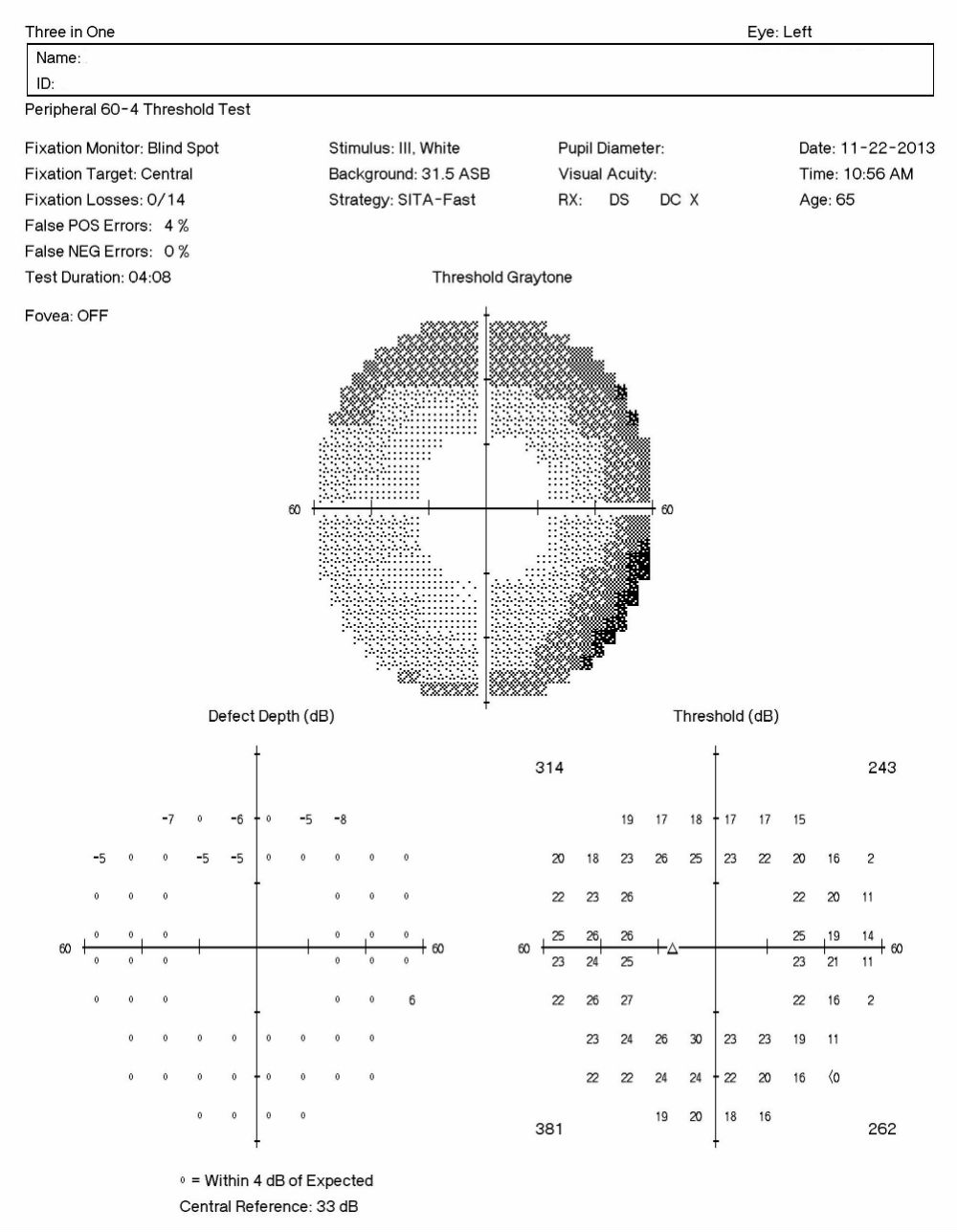 |
Fundus Photography
Photodocumentation is always a consideration when a disease is to be monitored over time for change. This would be more important in the cases where the reason the patient is a glaucoma suspect is based on actual changes in the optic nerve head or visible retinal nerve fiber layer.
Serial Tonometry
Knowing a patient’s pattern of intraocular pressure can be very elusive. Studies show that most patient’s highest pressure occurs during “non-office hours”. During normal business hours, most patient’s pressures are highest in the morning. These statements are only statistical norms with high degree of variation. To understand a patient’s pattern of IOP response, it is often necessary to obtain mulitple pressure readings either throughout the day (diurnal variation) or at multiple times over several days to weeks of time. Obtaining multiple (typically three or more) IOP readings in a single 24 hour period is termed serial tonometry and a separate diagnostic procedure.
Visual Evoked Potential Testing
The VEP is an objective electric sign of visual pathway function and its parameters are sensitive to abnormalities in the visual system. By measuring the speed and strength of the neural responses along the visual pathway, VEP testing evaluates the integrity of the afferent visual sensory system.
- Abnormal waveform peak latencies and shape helps to identify pathologies ranging from the eye through the brain to the primary visual cortex
- The procedure can be acomplished with the NOVA-DN VEP Testing Device manufactured by DIOPSYS.
Electroretinography
- Electroretinogram testing evaluates the integrity of the retina
- The procedure can be accomplished using the NOVA-ERG Testing Device manufactured by DIOPSYS
- Specialized pattern electroretinogram (PERG) test uses a contrast-reversing pattern for the stimulus to produce information about ganglion cell function
All of the diagnostic test results confirmed the initial diagnosis of glaucoma suspect, low risk (risk factors include race, age, ocular hypertension, mild vertical rim changes and symmetry and suspicious visual field changes). Additional diagnostic testing would include a repeat of the visual fields to document reproducibility and further evaluation of diurnal intraocular pressure.
According to Current Procedural Terminology, when eye doctors perform ophthalmological examinations, the complexity of medical decision-making is not separated from the examining techniques used. As a guideline to assist eye doctors in enhancing their medical decision-making skills, consider that the complexity of medical decision-making involves three components.
The first component concerns the number of possible diagnoses and treatment options that must be considered. Modern glaucoma diagnosis involves the determination of structural damage to the eye and/or functional loss to the visual system. Once these assessments are made, the glaucoma must be classified by type. The most specific diagnosis in this case would be H40.011-013, open-angle with borderline findings, low risk.
The second component concerns the amount and complexity of medical records and diagnostic tests that have to be obtained, reviewed and analyzed. In addition to an eye examination, this visit required the review and analysis of a subjective refraction, a retinal laser scan, a threshold visual field examination, fundus photography, electroretinography, gonioscopy and a evaluation of visual evoked potential test findings.
Third, the complexity of medical decision-making is affected by the risk of significant complications and/or morbidity associated with the risk of developing glaucoma. Designation as a glaucoma suspect was classified as a moderate problem where the risk of total vision loss without treatment was only a moderate concern. The treatment plan would ultimately involve monitoring the patient and repeat test results over time.
Treatment Guidelines
The suggestions involved in monitoring a patient as a glaucoma suspect are determined by the severity of the presentation and the specific risk factors that were considered in determining the patient is a glaucoma suspect.
- Optic nerve risks will involve more emphasis on imaging and OCT findings.
- IOP factors will involve monitoring IOP at different times of the day over a longer period of time.
- Once baseline data is obtained, a patient who is a mild glaucoma suspect could be seen every 6-12 months while a moderate suspect may require more frequent testing.
- Although unusual, it is possible that at a point in time a patient could be no longer considered a suspect based on stability of the findings.
Treatment Program
There is no specific treatment for glaucoma suspects. Counseling can be provided regarding maintaining a healthy lifestyle, increasing aerobic exercise, smoking cessation and additional anti-oxidant supplements.
Next visit scheduled for one month to repeat the visual field and obtain an additional IOP measurement.
Discussion
This case demonstrates several key aspects of monitoring a patient classified as a glaucoma suspect.
- First, no additional or second opinions are required. The patient requires no surgical treatment or medication, only monitoring of the pertinent findings.
- Second, this patient’s clinical history supports the modern understanding of the pathophysiology of glaucoma. We know that glaucoma is an optic neuropathy. Structural damage to the retinal nerve fiber layer is usually the first milestone in the natural history of glaucoma. The loss of retinal nerve fibers is closely followed by changes in the appearance of the optic disc. Functional loss, which is documented by abnormal visual field testing, abnormal electrodiagnostic test results or loss of visual acuity, usually occurs later in the natural history of the disease.
- Third, even though this patient had structural damage to the retinal nerve fiber layer, the defects were not characteristic of glaucoma-induced RNFL fallout and there was no clinically significant functional loss based on visual fields and electrodiagnostics.
Based on the patient history, the nature of the presenting problem, and my own clinical judgement this patient needed an evaluation of the complete visual system.
- Perform the eye examination that is medically necessary
- Provide the diagnostic tests or services that are medically necessary
- Properly document the services provided
- Code from the documentation
- Report the services to the payor
Physicians Quality Reporting System
PQRS Measure 226: Patient screened for tobacco use and identified as a non-user of tobacco – CPT code 1036F
This measure applies to patients 18 years and older. The measure should be reported on the day of the examination and can be used with any diagnosis code.
PQRS Measure 130: Current Medicatons with Name, Dosage, Frequency and Route Documented – CPT code G8427
This measure applies to patients 18 years and older. The measure should be reported on the day of the examination and can be used with any diagnosis code.
Multiple Procedure Payment Reduction
Effective January 1, 2013, there is a small reduction in payment from Medicare if certain multiple procedures are billed on the same day. The fee for the technical component of the diagnostic test for the second and subsequent tests will be reduced by 20%. The second diagnostic test and subsequent tests should be reported with a -51 modifier. Professional services such as gonioscopy, extended ophthalmoscopy, serial tonometry and provocative glaucoma testing are excluded from this policy. Visual evoked potential testing is excluded from this policy.
Modifier 51
This modifier is used to identify the secondary procedure or when multiple procedures are performed on the same day by the same provider. List the major primary procedure first and append the modifier to the subsequent procedures. The primary procedure is the one with the highest dollar value.
INITIAL EXAMINATION — DAY 1
| Diagnosis Code | Procedure Code | Modifier | Quantity | Payor | Amount Allowed |
| H40.013 - Open-angle glaucoma with borderline findings, low risk, bilateral | 92004 - Medical eye examination | 1 | Medicare | 152.38 | |
| H40.013 - Open-angle glaucoma with borderline findings, low risk, bilateral | 92083 - Visual field examination | 51 | 1 | Medicare | 59.63 |
| H40.013 - Open-angle glaucoma with borderline findings, low risk, bilateral | 92020 - Gonioscopy | 1 | Medicare | 28.09 | |
| H40.013 - Open-angle glaucoma with borderline findings, low risk, bilateral | 92250 - Fundus photography | 1 | Medicare | 80.06 | |
| H40.013 - Open-angle glaucoma with borderline findings, low risk, bilateral | G8427 - Medications documented | Medicare | 0.00 | ||
| H40.013 - Open-angle glaucoma with borderline findings, low risk, bilateral | 1036F - Patient screened for tobacco use | Medicare | 0.00 | ||
| Total | $320.16 |
SUBSEQUENT ENCOUNTER — ONE MONTH
| Diagnosis Code | Procedure Code | Modifier | Quantity | Payor | Amount Allowed |
| H40.013 - Open-angle glaucoma with borderline findings, low risk, bilateral | 92012 - Medical eye examination | 1 | Medicare | 87.69 | |
| H40.013 - Open-angle glaucoma with borderline findings, low risk, bilateral | 92083 - Visual field examination | 51 | 1 | Medicare | 59.63 |
| H53.412 - Scotoma involving central area, left eye | 92275 - Electroretinography | 1 | Medicare | 167.58 | |
| H53.412 - Scotoma involving central area, left eye | 95359 - Visual evoked potential | 1 | Medicare | 135.58 | |
| H40.013 - Open-angle glaucoma with borderline findings, low risk, bilateral | G8427 - Medications documented | Medicare | 0.00 | ||
| H40.013 - Open-angle glaucoma with borderline findings, low risk, bilateral | 1036F - Patient screened for tobacco use | Medicare | 0.00 | ||
| Total for both visits | $770.64 |
H40.011
Open-angle glaucoma with borderline
findings, low risk,
right eye
H40.012
Open-angle glaucoma with borderline
findings, low risk,
left eye
H40.013
Open-angle glaucoma with borderline
findings, low risk,
bilateral
H40.021
Open-angle glaucoma with borderline
findings, high risk,
right eye
H40.022
Open-angle glaucoma with borderline
findings, high risk,
left eye
H40.023
Open-angle glaucoma with borderline
findings, high risk,
bilateral
365.01
Open-angle glaucoma suspect
92133
Retinal laser scan
92250
Fundus photography
95930
Visual evoked potential
92275
Electroretinography
92225
Extended ophthalmoscopy
76514
Corneal pachymetry
92020
Gonioscopy
92283
Color vision testing
92132
Anterior segment imaging
76513
Anterior segment ultrasound




 Print | Share
Print | Share